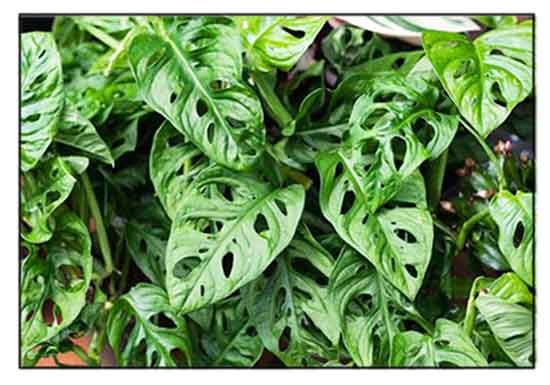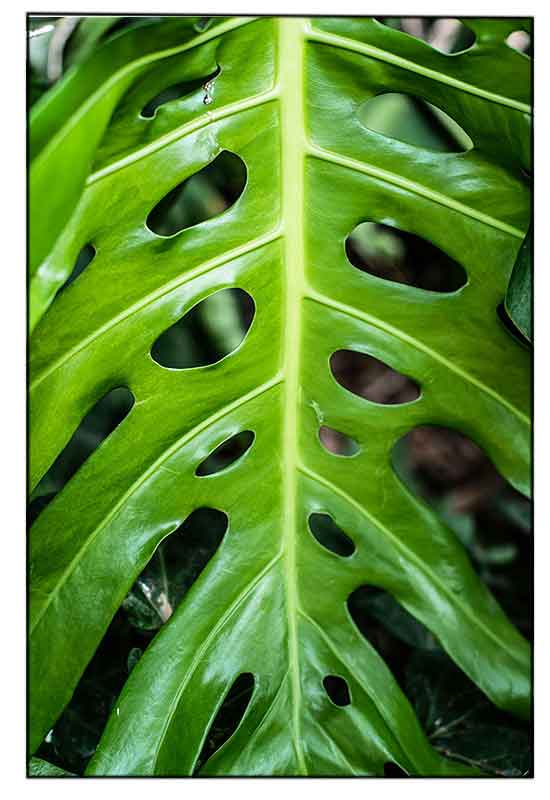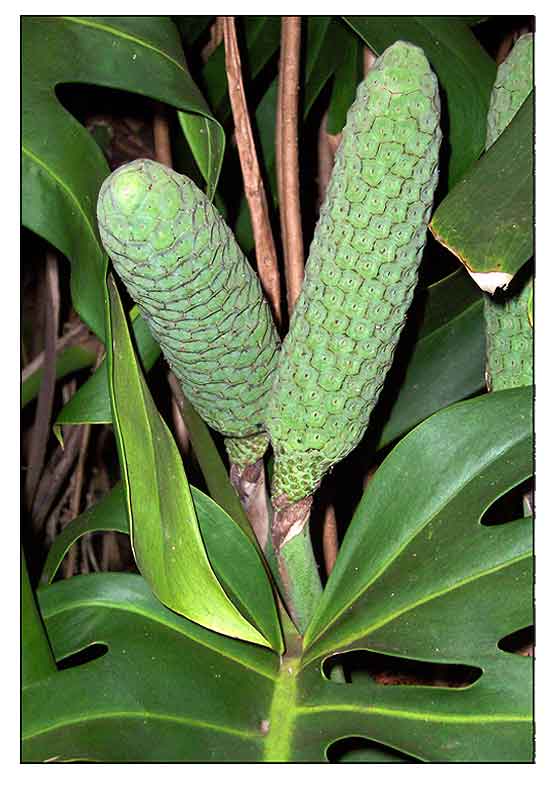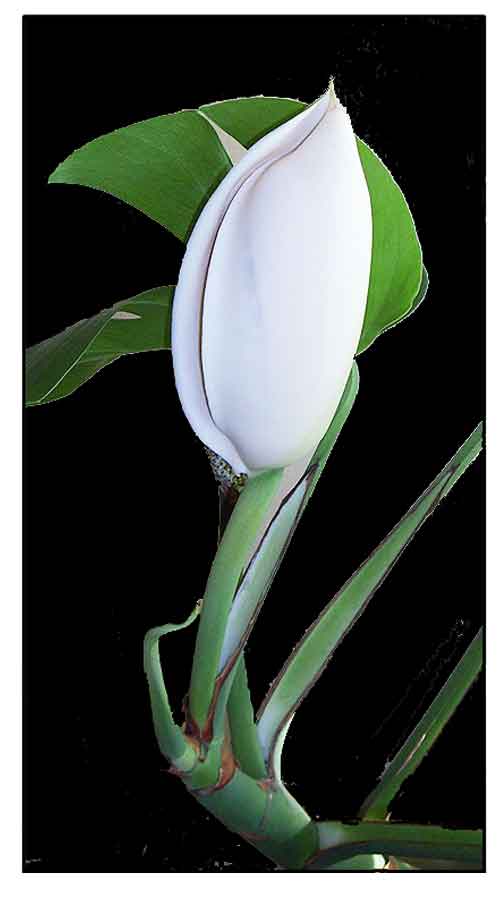 Gen info Gen info
- The genus Monstera comprises about 50 species of flowering plants belonging to the arum family Araceae.
- Common name "Swiss cheese plant" derives from its distinctively shaped, deeply divided, glossy green leaves with holes that resemble various types of Swiss cheeses, such as Emmental cheese.
- Etymology: The genus name Monstera means "monstrous" or "abnormal" in Latin, referring to the unusual leaves with natural holes.
(2) The species epithet deliciosa means "delicious", referring to the edible fruit. Literally, the scientific name means "delicious monstrosity".
- While common names refer to it as "philodendron", it does not belong in the genus Philodendron.
- It is said to be popular houseplant in the Philippines.
 Botany Botany
• Monstera deliciosa is a hemiepiphyte with aerial roots. In the wild, it can reach a height of 20 m (66 ft), and its enormous, glossy, pinnate, leathery, heart-shaped leaves are 25–90 cm (10–35.5 in) long by 25–75 cm (10–29.5 in). Young plants have tiny, complete leaves without lobes or holes, but as they mature, they rapidly develop lobes and fenestrate leaves. Although it can reach heights of up to 3 m (6.6 ft) in the wild, it only reaches heights of 2–3 m (6.6–9.8 ft) when grown inside. The typical big perforations are more prevalent on the leaves of an older plant. In Monstera deliciosa, there are three different kinds of roots: aerial roots, aerial roots that have penetrated the ground (aerial-subterranean roots), and lateral roots that develop on aerial-subterranean roots (lateral-subterranean roots). The anatomical maturation and growth of the three root types varied. Aerial roots had the greatest elongation rate and greatest elongation zone. The accelerated elongation rate of aerial roots was correlated with an elongation zone that enlarged with time. (2)
• Monstera deliciosa is a large root climber. Foliage: Leaves leathery, mid to dark green, 30 - 90cm wide, blades dissected and with perforations. Petioles flattened, to 1m long. Flowers: Inflorescence to 25 (30)cm long, spathe white. Fruit: Compound fruit to 30(40)cm long by 9cm wide. Fruits hexagonal cells to 1cm wide, tightly fitted together, edges loosening when ripe. (10)
Distribution
- Introduced.
- Widely cultivated as an outdoor ornamental or houseplant.
- Native to Guatemala, Mexico Gulf, Mexico Southeast, Mexico Southwest. (1)
- Introduced to many tropical areas, and has become mildly invasive in Hawaii, Seychelles, Ascension Island and the Society
Constituents
- Phytochemical screening of fruit kernels extracts yielded carbohydrates, steroids, saponins, tannins, and phenolic compound. (see study below) (4)
- Methanolic extract of leaves yielded 25.7µg of phenol compound in 1000 µgm. (see study below) (5)
 Properties Properties
- As the fruit ripens scales or platelets fall off, releasing a strong and sweet scent, which is compared to a combination of pineapples and bananas, hence, the fruit salad plant name. (3)
- Unripe fruit often contain raphides and trichosclerids - needle-like crystalline calcium oxalate structures that can cause irritation of the mouth. (3)
- First sign of ripening is yellowing of the lowest scales. When half-ripe, the odor becomes noticeable. Fully ripe, the scent rapidly lessens. (3)
- Studies have suggested antioxidant, anticancer, antidiabetic properties.
Toxicity
- All parts of the plant contain calcium oxalate crystals, which if eaten or chewed can cause immediate pain, burning, and swelling of the if the lips, mouth, tongue, and throat. Swelling may be accompanied by copious salivation, difficulty in breathing, swallowing, or speaking. Nausea, abdominal pain, and gastric irritation may occur. The fruit, while considered edible when ripe, may cause hives and an itchy rash. (8)
-
Toxic to both cats and dogs due to the insoluble calcium oxalate crystals. Direct contact can cause dermatitis in cats and dogs. They can cause injury to the mouth, tongue, and digestive tract. (3)
Parts used
Roots, fruits, leaves.
Uses
Edibility
- Flowers develop into an edible fruit, which tastes like "fruit salad". (2)
Folkloric
- In Mexico, root infusion used for treatment of arthritic pains. In Martinique, roots used for treatment of snakebites. In Brazil, mashed and warm leaves used to cauterize wounds. In China, used for treatment of fever, infections, bruises, and coughs. (2)
Others
- Crafts: In Mexico and Peru, roots used as rope and basket weaving material. (2)
 Studies Studies
• Antioxidant / Fruits: Study evaluated phytochemical contents and invitro antioxidant activities of various solvent extracts of M. deliciosa fruit kernels. Antioxidant activity of isolated compound from ethanolic extract showed strong DPPH free radical scavenging activity. (see constituents above) (4)
• Antioxidant / Total Phenolic Content / Leaves: Study evaluated a methanolic extract f M. deliciosa leaves for free radical scavenging and total phenolic content. The extract exhibited significant antioxidant activities in a dose dependent manner with IC50s for the methanol extract and standard ascorbic acid of 77.87 µg/mL and 20.73 µg/ml for DPPH assay, 81.30 and 33.53 µg/ml for nitric oxide, 85.33 and 25.33 µg/mL for superoxide, and 89.33 and 39.33 µg/mL, respectively. (5)
• Anticancer / Leaves: Study evaluated the antitumor and antioxidant status of methanol extract of M. deliciosa on Ehrlich ascites carcinoma (EAC) treated mice, assessing tumor volume, viable and nonviable tumor cell count, tumor weight, hematological and biochemical parameters. The MEMD showed direct cytotoxicity on EAC cell line in a dose dependent manner. There was significant (p<0.05) decrease in tumor volume, viable cell count, tumor weight and elevated life span of EAC tumor bearing mice. (6)
• Effect on Insulin Secretion: In an invitro testing of medicinal plants from Islamabad and the Murree region for insulin secretagogue activity, Monstera deliciosa, along with Artemisia roxburghiana and Salvia coccinia, showed insulin secretagoge activity at 1 microg/mL (p<0.05). (7)
• Adaptive Function of Leaf Fenestration: Study evaluated the functional significance of the holes in Monstera deliciosa leaves for three of the most generally accepted hypotheses: water intake, wind damage reduction, and herbivory deterrence. Monstera leaves with holes were found to have a significantly highest amount of water capture by the roots of the plant than leaves without holes. Holes did not have a very large impace of degree of wind damage that a plant endures, and presence of holes actually increase the level of herbivory on a given leaf. Results confirm the holes in Monstera leaves are an adaptive function for increasing water uptake efficiency, rather than an adaptation to decrease damage from water or herbivory pressures. (9)
Availability
Wild-crafted.
Plants in the cybermarket.
|

![]()



 Gen info
Gen info

 Studies
Studies 